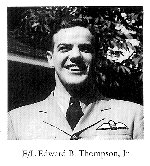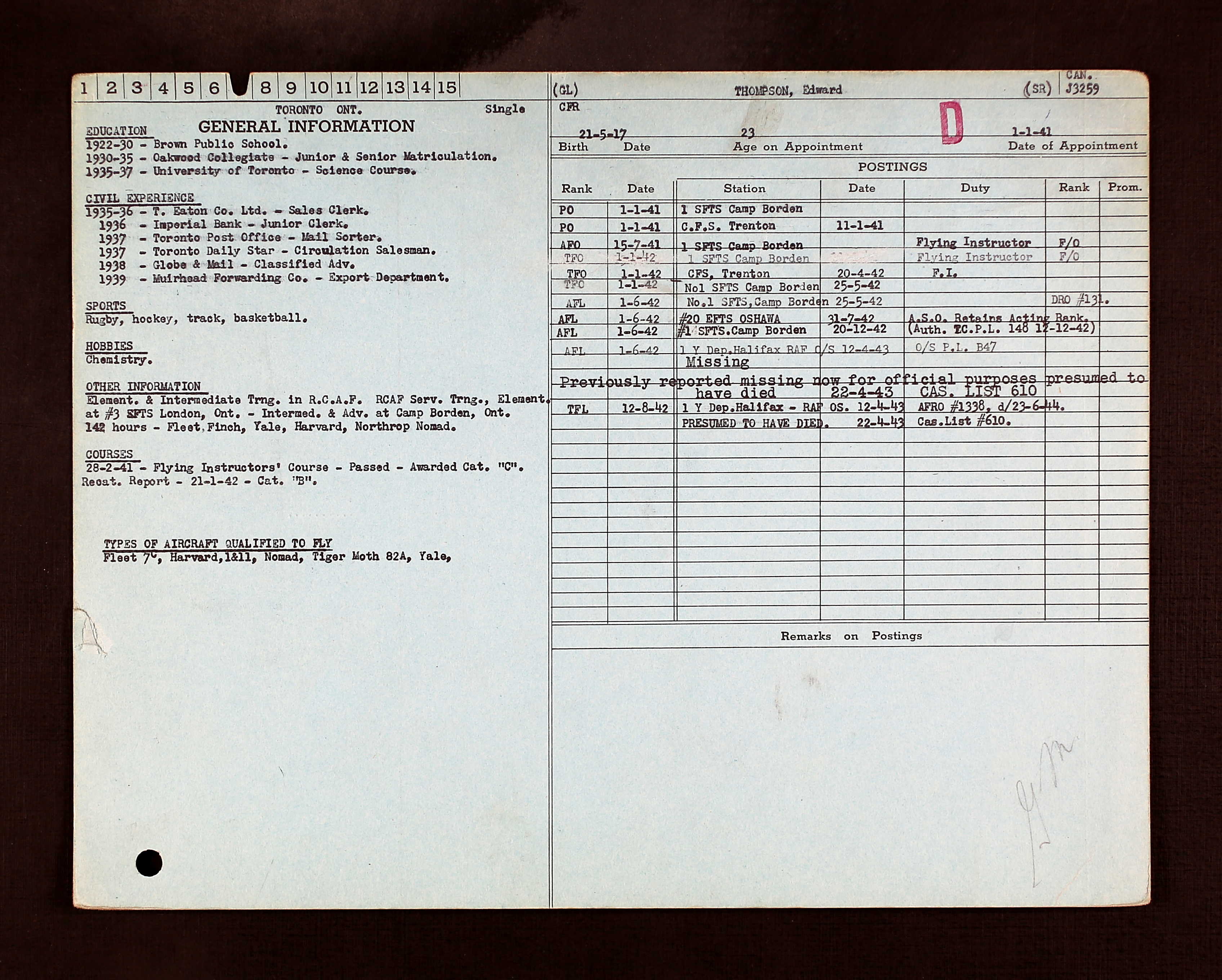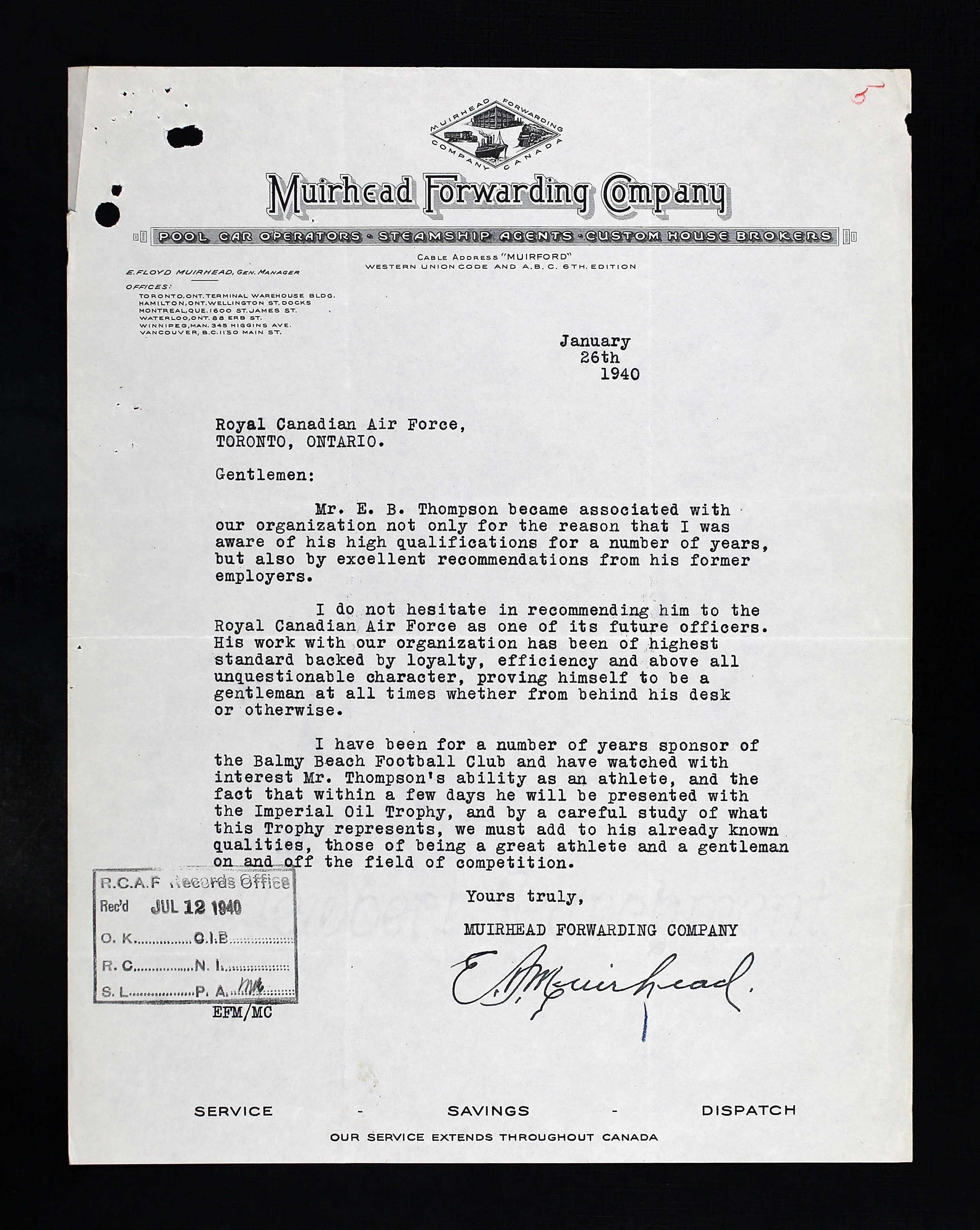



May 21, 1917 - April 22, 1943




Edward Blake Thompson was the son of Edward Blake Thompson, Sr., broker, (1881-1956) and Margaret Irene (nee Campbell) Thompson (1880-1965) of Toronto, Ontario. Alexander Campbell Thompson (1906-1975), Mary Isabel Burden (1911-1988) were his older siblings. Margaret Phyllis Thompson, (V30203), a Section Officer, RCAF, WD, overseas, was his younger sister. The family attended the United Church.
Eddie attended school from 1922 to 1930, then Oakwood Collegiate from 1930 to 1935 where he earned his senior matriculation, with honours. He attended the University of Toronto (Trinity College) from 1935 to 1938 studying Political Science and Science, plus Arts, but did not finish. He indicated he could read French and Spanish.
Eddie worked at many jobs from December 1936 until his enlistment in January 1940: salesclerk at T. Eaton Co., mail sorter with the post office, sales in circulation with the Toronto Daily Star, a clerk at the Imperial Bank of Canada, advertising/classifieds at Globe and Mail, and as an assistant manager at Muirhead Forwarding Co., an export company, Toronto and lived with his parents. He had $99.50 in savings with the Bank of Nova Scotia. After the war, he hoped to remain in the RCAF.
He liked to play rugby (was knocked out once during a game), swim, play hockey, and football, where he was the captain of a team. He listed chemistry as a hobby and had some knowledge of mechanics through university. He stood 5’ 7½” tall and weighed 170 pounds. “Overweight due to muscular development.” He had blue eyes and dark brown hair, with a medium complexion. “Absolutely A1 type. Perfect gentleman. Splendid physique. A great sport in everything. Strongly recommended for Commission. Should make an excellent pilot. Very good education.”
One of his references included Air Marshall Billy Bishop, VC, DSO, MC.
After applying in September 1939 and again in January 1940, the RCAF accepted Eddie at the Recruiting Centre, June 6, 1940, in Toronto. He was 23. He was sent to No. 1 Manning Depot, Toronto to begin his journey through the BCATP.
He was sent to No. 1 ITS, Toronto from June 24, 1940 for one month. “6th in his class. 92%.”
Then Eddie was at No. 3 EFTS, London, Ontario to begin pilot training. “78% and 8th in class.”
He had intermediate training at Camp Borden, Ontario from September 19, 1940 until November 14, 1940 and passed with a 67.9% and was 20th in his class. He earned his wings on November 21, 1940.
From there, he took Advanced Training at Camp Borden, finishing on December 31, 1940. “11th with 71.24%.”
Eddie completed instruction in Flying Instructors’ Course, Trenton, Ontario from January 12, 1941 to February 28, 1941. “He flies and demonstrates well. More aerobatic practice needed.” He was excused on ground subjects. His voice was clear, he was enthusiastic, was able to impart knowledge well. “An above average pilot of very wide experience who has shown exceptional keenness and initiative on his course. Will be a very valuable instructor.”
In May 1941, No. 1 SFTS, Camp Borden: “Has been a flying instructor in No. 2 Squadron for two months. Has only recently been commissioned after passing out at the head of this training course at Camp Borden and after completing an instructor’s course at CFS, he returned to No. 1 SFTS as an instructor with a ‘C’ category. Has good powers of command and is an exceedingly hard worker and an asset to his unit. Recommended that he be promoted to next rank.” Edward was in the station hospital from September 7-10, 1941.
November 24, 1941, No. 1 SFTS Camp Borden: “Has been instructing on this station for 8 months. During this time he has done good work and is now Deputy Flight Commander of H Flight. He is keen and conscientious and has availed himself of the facilities to improve his administrative ability. His dress and deportment are very good. He has a pleasant personality and is popular throughout this Station.” P/O Thompson was further assessed, “A very good pilot and instructor. Not fully up to date on modern Elementary Flying Training but is more familiar with advanced training.”
In April 1942, he was in Trenton for about a month.
Eddie was at No. 20 EFTS, Oshawa, Ontario, July 31, 1942 until he was sent back to No. 1 SFTS, Bordon, December 12, 1942 until March 28, 1943.
Eddie flew a variety of aircraft: Lockheed 12, Anson Mk 3, Fleet, Yales, Harvard, Nomad, Tiger Moth, and Crane throughout his time in Canada.
Eddie had $1,050 in Victory Loan Bonds and an insurance policy. Mrs. Thompson was the sole beneficiary.
Eddie traveled to Halifax and was taken on strength at the Y Depot March 29, 1943. By April 13th, he was attached to the RAF Trainees’ Pool, awaiting transportation overseas.
On April 22, 1943, Eddie was aboard the Amerika, British Motor merchant ship. It was on its way from Halifax, Nova Scotia to Liverpool. It was torpedoed as the ship was heading to Britain. It was a straggler in convoy HX-234. Thirty-seven men, all officers in the RCAF, were presumed missing as a result of enemy action at sea; sixteen were landed at a British port after their ship was sunk by U-306, south of Cape Farewell, off Greenland. Forty-two crew members and seven gunners were also amongst those who were lost. The master, Christian Nielsen, 29 crewmembers, eight gunners, and sixteen passengers were picked up by the HMS Asphodel, and landed at Greenock. General cargo, including metal, flour, meat and 200 bags of mail were also lost.
In early May 6, 1943, Mr. Thompson received a letter from F/L Gunn, RCAF Casualties Officer for Chief of the Air Staff. “Regretfully, I must confirm my telegram of May 5th advising that your son is missing at the result of enemy action at sea. For reasons of security, it is not possible to convey anything further to you at this time, but you may be assured that when it is possible to communicate additional information, it will be don so at once. May I extend to you and Mrs. Thompson my sincere sympathy in this time of great anxiety.”
In late June 1943, Mrs. Thompson received another letter from F/L Gunn, including a list of the names and next-of-kin of the sixteen RCAF Officers who survived. "Since my letter of May 6th, no additional news has been received. Attached is a list of the names and next-of-kin of sixteen Royal Canadian Air Force officers who embarked on the same ship as your son and following enemy action at sea were safely landed in the United Kingdom. The following official statement was made in the House of Commons....’I have been in receipt of communications from a number of members of this house and from people outside with reference to rumours regarding the recent loss of a number of members of the RCAF by the sinking of a ship in the north Atlantic and I desire to make the following statement on the facts. The vessel in question was a ship of British registry of 8,862 tons, designed for peace-time carriage of both passengers and freight, and having a speed of fifteen knots. She carried a crew of 86 and the passenger accommodation consisted of 12 two-berth rooms with bath and 29 other berths, providing cabin accommodations for 53 passengers. She was fitted with lifeboat capacity for 231 and travelled in naval convoy. Under the recently revised regulations agreed to by the United States authorities, the joint United Kingdom and United States shipping board, the Admiralty, the Air Ministry and the Canadian authorities, a vessel of this description travelling in convoy is permitted to embark as crew and passengers a maximum of 75% of the lifeboat capacity. The lifeboat capacity as stated above was 231, 75% of which is 173. Personnel on board consisted of the crew of 86, and RCAF personnel numbering 53, a total of 139, well within the prescribed limits. Because of the superior type of available passenger accommodation, the speed of the ship and the provision of naval convoy, the offer of the entire available space to the RCAF was immediately accepted. Rumours to the effect that this was a slow freighter not suitable for passenger accommodation are, of course, not in accord with the facts. Every precaution was taken to safeguard the lives of these gallant young men. It should be pointed out that on account of the serious shipping shortage every available berth on such ships must be used, and had the space not been taken up by the RCAF officers of the other arms of the services would have been placed on Board. It should also be stated again that the submarine is still the enemy’s most powerful weapon and that the Battle of the Atlantic is not yet won. Any ocean trip today in any part of the world is fraught with danger and I think I safely say that our record in transporting our soldiers and airmen to the United Kingdom is one of while we may all be proud. No one deplores more than I do the loss of 37 of the finest of our young men who gave their lives for their country as surely as if they had done so in actual combat with the enemy, and I extend my deepest sympathy to their loved ones in their bereavement.’ If further information becomes available, you are to be reassured it will be communicated to you at once. May I again extend to you my sincere sympathy in this time of great anxiety."
In January 1944, Mr. Thompson received a letter from Air Marshall Robert Leckie informing him that Edward was now officially presumed to have died on Active Service on April 22, 1943.
In late February 1944, Edward’s brother, Alex, a lawyer, wrote to the Estate Branch, Ottawa. “I understand particulars re: the estate of the above have been forwarded to you. There is one item which I believe was overlooked. In April 1943, he purchased five (5) £2.00 CPR Express Travellers’ cheques being No. 123610 to 123614 inclusive from his bank, Bank of Nova Scotia. Forest Hill Village. As none of these were likely cashed or if cashed will be presented for payment, I suppose these should be added to the assets and the value claimed from the CPR Express.”
In October 1955, a letter addressed to Mrs. Thompson arrived from W/C Gunn stating since that Edward had no known grave, his name would appear on the Ottawa Memorial.